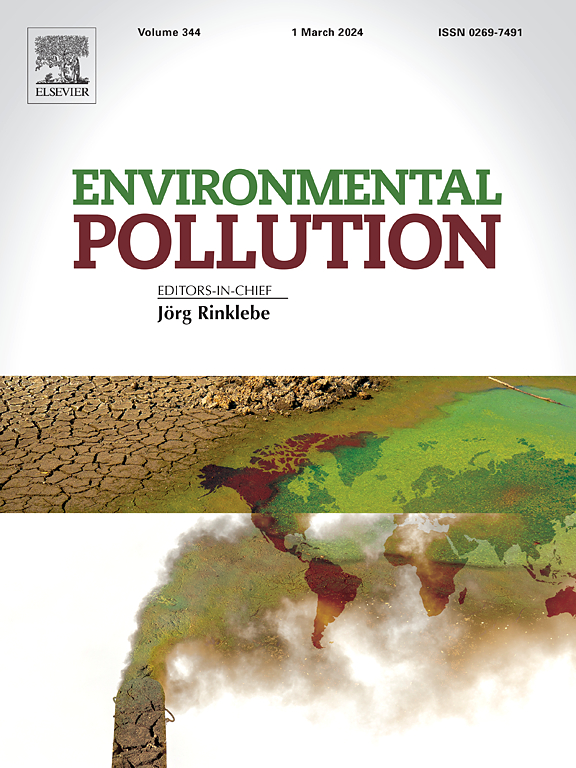Long-term ambient ozone exposure and lung cancer mortality: a nested case-control study in Korea
IF 7.6
2区 环境科学与生态学
Q1 ENVIRONMENTAL SCIENCES
引用次数: 0
Abstract
The link between long-term exposure to tropospheric ozone (O3) and risk of lung cancer mortality remains uncertain. We aimed to provide new insights into the association between long-term O3 exposure and lung cancer mortality in Korea. A nested case-control study was conducted within a cancer-free cohort of 1,731,513 individuals who underwent health screenings provided by the National Health Insurance Service in 2006–2007. A total of 7,133 lung cancer deaths that occurred from January 1, 2012, to December 31, 2021, were matched to 28,532 controls at a 1:4 ratio based on propensity scores. Daily 24-hour and 8-hour maximum O3 concentrations, averaged year-round and during the warm season from 2006 to 2010, were estimated for participants based on their residential addresses using the Community Multiscale Air Quality model. O3 concentrations rise during the daytime, also exhibiting seasonal variations, with the highest levels occurring in the warm season. Elevated risk of lung cancer mortality was observed among participants in the highest quartile of O3 exposure compared with those in the lowest quartile, yielding odds ratios ranging from 1.15 to 1.27. However, when exposure to particulate matter with an aerodynamic diameter of 2.5 μm or less (PM2.5) was further adjusted for, the adverse risk of long-term O3 exposure was attenuated, even tending to be protective. Notably, participants with both high O3 and high PM2.5 exposures had an increased risk of lung cancer mortality. Furthermore, regional differences were observed, with a significantly higher risk in rural areas. Findings of this study suggest that long-term exposure to O3, especially in combination with PM2.5 exposure, is associated with an excess risk of lung cancer mortality, underscoring the importance of addressing the O3 and PM2.5 interaction in lung cancer prevention.

长期环境臭氧暴露与肺癌死亡率:韩国的巢式病例对照研究
长期暴露于对流层臭氧(O3)与肺癌死亡风险之间的关系仍不确定。我们的目的是对韩国人长期暴露于臭氧与肺癌死亡率之间的关系提供新的见解。我们在一个无癌症队列中开展了一项嵌套病例对照研究,该队列中有 1,731,513 人在 2006-2007 年期间接受了国民健康保险服务机构提供的健康检查。根据倾向得分,将 2012 年 1 月 1 日至 2021 年 12 月 31 日期间的 7,133 例肺癌死亡病例与 28,532 例对照病例按 1:4 的比例进行了匹配。利用社区多尺度空气质量模型,根据参与者的居住地址估算出 2006 年至 2010 年全年和暖季的每日 24 小时和 8 小时最大臭氧浓度平均值。臭氧浓度在白天升高,也呈现季节性变化,暖季时浓度最高。与暴露于最低四分位数的人群相比,暴露于最高四分位数的人群肺癌死亡风险更高,几率比为 1.15 至 1.27。然而,如果进一步调整暴露于空气动力直径为 2.5 μm 或更小的颗粒物(PM2.5)的情况,则长期暴露于臭氧的不利风险会减弱,甚至有保护作用。值得注意的是,同时暴露于高浓度臭氧和高浓度 PM2.5 的参与者肺癌死亡风险增加。此外,研究还发现了地区差异,农村地区的风险明显更高。这项研究的结果表明,长期暴露于臭氧,尤其是同时暴露于 PM2.5 的情况下,与肺癌死亡的超额风险有关,这突出了在肺癌预防中解决臭氧和 PM2.5 相互影响问题的重要性。
本文章由计算机程序翻译,如有差异,请以英文原文为准。
求助全文
约1分钟内获得全文
求助全文
来源期刊

Environmental Pollution
环境科学-环境科学
CiteScore
16.00
自引率
6.70%
发文量
2082
审稿时长
2.9 months
期刊介绍:
Environmental Pollution is an international peer-reviewed journal that publishes high-quality research papers and review articles covering all aspects of environmental pollution and its impacts on ecosystems and human health.
Subject areas include, but are not limited to:
• Sources and occurrences of pollutants that are clearly defined and measured in environmental compartments, food and food-related items, and human bodies;
• Interlinks between contaminant exposure and biological, ecological, and human health effects, including those of climate change;
• Contaminants of emerging concerns (including but not limited to antibiotic resistant microorganisms or genes, microplastics/nanoplastics, electronic wastes, light, and noise) and/or their biological, ecological, or human health effects;
• Laboratory and field studies on the remediation/mitigation of environmental pollution via new techniques and with clear links to biological, ecological, or human health effects;
• Modeling of pollution processes, patterns, or trends that is of clear environmental and/or human health interest;
• New techniques that measure and examine environmental occurrences, transport, behavior, and effects of pollutants within the environment or the laboratory, provided that they can be clearly used to address problems within regional or global environmental compartments.
 求助内容:
求助内容: 应助结果提醒方式:
应助结果提醒方式:


